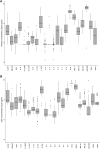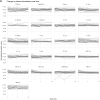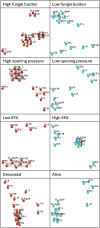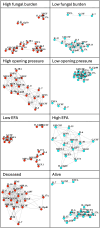Relative Contribution of Pharmacokinetics and Immune Signatures to Clinical Outcomes in Patients With HIV-associated Cryptococcal Meningitis
- PMID: 40271162
- PMCID: PMC12015468
- DOI: 10.1093/ofid/ofaf190
Relative Contribution of Pharmacokinetics and Immune Signatures to Clinical Outcomes in Patients With HIV-associated Cryptococcal Meningitis
Abstract
Background: Host immune responses to HIV-associated cryptococcal meningitis are critical in disease outcome. Their interaction with antifungal drug exposure is poorly understood. This study explored associations between immune biomarkers, antifungal drug exposure, and clinical outcomes in HIV-associated cryptococcal meningitis.
Methods: We analyzed serial plasma and cerebrospinal fluid immune biomarkers from 64 participants recruited from the AMBITION-cm trial. We estimated individual-level exposure to amphotericin B, flucytosine, and fluconazole. Associations between immune biomarkers, pharmacokinetic parameters, and clinical outcomes were evaluated.
Results: An inflammatory cerebrospinal fluid response, characterized by coordination between tumor necrosis factor-α, granulocyte colony-stimulating factor, and interleukin-7 signaling, was linked to low fungal burden, low intracranial pressure, and survival. However, the value of specific immune biomarkers did not predict EFA or mortality. Exposure to amphotericin B was significantly associated with EFA.
Conclusions: Favorable clinical outcomes from HIV-associated cryptococcal meningitis are associated with coordinated inflammatory and cytotoxic responses in the central nervous system. Antifungal drug exposure was the dominant predictor of EFA.
Keywords: amphotericin B; cryptococcal meningitis; immunomodulation; pharmacodynamics; pharmacokinetics.
© The Author(s) 2025. Published by Oxford University Press on behalf of Infectious Diseases Society of America.
Conflict of interest statement
Potential conflicts of interest. We declare no conflicts of interest.
Figures






References
-
- Molloy SF, Kanyama C, Heyderman RS, et al. Antifungal combinations for treatment of cryptococcal meningitis in Africa. N Engl J Med 2018; 378:1004–17. - PubMed
Grants and funding
LinkOut - more resources
Full Text Sources

